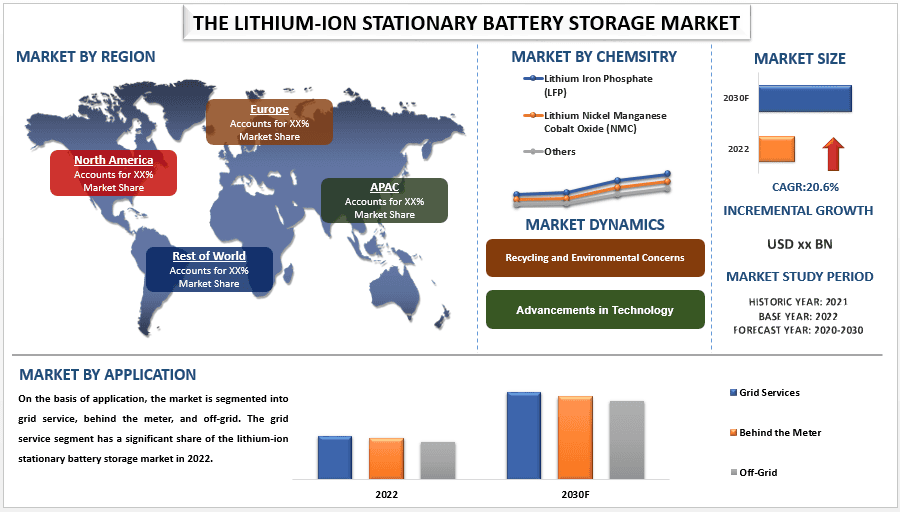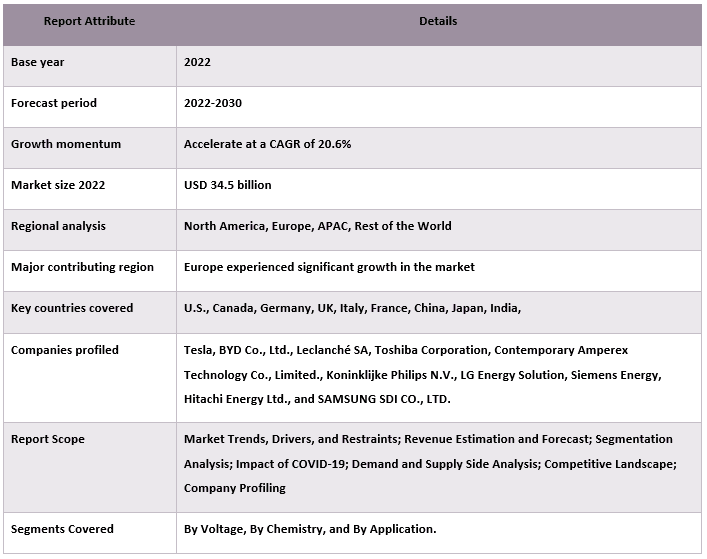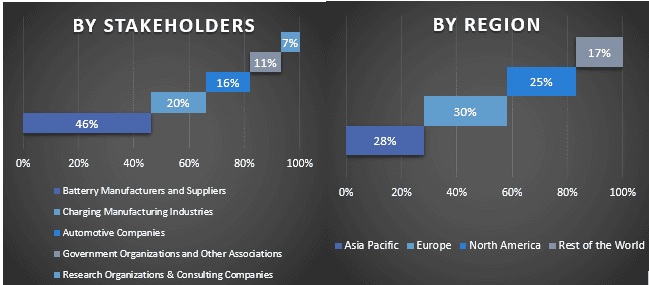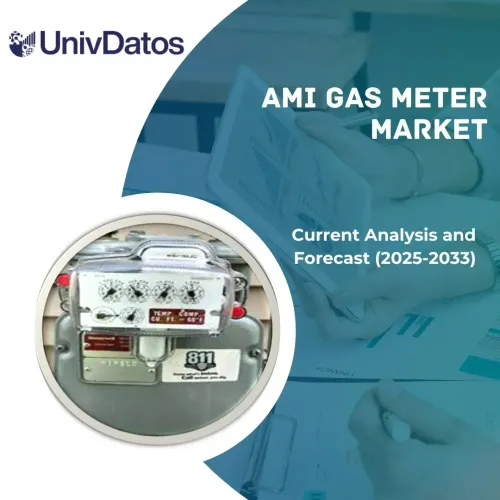- Home
- About Us
- Industry
- Services
- Reading
- Contact Us
Lithium-Ion Stationary Battery Storage Market: Current Analysis and Forecast (2023-2030)
Emphasis on Chemistry (Lithium Iron Phosphate (LFP), Lithium Nickel Manganese Cobalt Oxide (NMC), and Others); and Voltage (Low-Voltage Systems, Medium-Voltage Systems, High-Voltage Systems, and Extra-High-Voltage Systems); Application (Grid Services, Behind the Meter, and Off-Grid) and Region/Country

The lithium-ion stationary battery storage market is expected to grow at a strong CAGR of around 20.6% during the forecast period. The global shift toward renewable energy sources, such as solar and wind power, has created a need for energy storage to balance the intermittent nature of these sources. Lithium-ion stationary battery storage systems enable the efficient storage and release of renewable energy, making it a key driver of market growth. Moreover, the Aging electrical grids, along with an increase in extreme weather events and power demand, have led to a need for grid stability and reliability. Battery storage systems provide grid services such as frequency regulation, peak shaving, and backup power, enhancing the resilience and efficiency of grids. Furthermore, Ongoing advancements in lithium-ion battery technology, including increased energy density, improved performance, and cost reductions, have made stationary battery storage systems more efficient and affordable. For example, Siemens unveiled its Junelight Smart Battery for residential energy storage in 2020. The company aimed to compete in the growing market for home battery solutions, particularly for solar energy self-consumption.
Some of the major players operating in the market include Tesla, BYD Co., Ltd., Leclanché SA, Toshiba Corporation, Contemporary Amperex Technology Co., Limited., Koninklijke Philips N.V., LG Energy Solution, Siemens Energy, Hitachi Energy Ltd., and SAMSUNG SDI CO., LTD. Several M&As along with partnerships have been undertaken by these players to facilitate customers with hi-tech and innovative products/technologies.
Insights Presented in the Report
“Amongst chemistry, the lithium nickel manganese cobalt oxide (NMC) segment held significant growth in the market in 2022.”
Based on chemistry, the market is segmented into lithium iron phosphate (LFP), lithium nickel manganese cobalt oxide (NMC), and others. Amongst these, the lithium nickel manganese cobalt oxide (NMC) segment held significant growth because NMC batteries offer a high energy density, which means they can store a large amount of energy in a relatively compact space. This is particularly important for stationary battery storage systems where space may be limited. Moreover, NMC batteries have shown improvements in performance, such as higher energy efficiency and longer cycle life. These characteristics make them well-suited for stationary energy storage applications, where reliability and longevity are essential.
“Amongst applications, the behind-the-meter segment held the significant growth of the market in 2022.”
Based on application, the market is segmented into grid service, behind the meter, and off-grid. Among these, three-wheelers held significant growth in the lithium-ion stationary battery storage market in 2022. The significant growth of three-wheelers can be attributed to Behind-the-meter energy storage systems allowing businesses and homeowners to store excess electricity during off-peak hours when electricity rates are lower and discharge it during peak hours when rates are higher. This helps reduce electricity bills and provides cost savings over time. Moreover, Energy storage systems installed behind the meter can provide backup power during grid outages or emergencies. This added resilience is appealing to homeowners, businesses, and critical infrastructure facilities, making them less reliant on the grid and improving overall energy security.
“Europe is experiencing significant growth in the lithium-ion stationary battery storage market in 2021.”
Europe has been aggressively transitioning to renewable energy sources, such as wind and solar power. To effectively harness these intermittent sources, energy storage is crucial. Lithium-ion batteries store excess energy during times of high renewable generation and release it when needed, thereby enhancing grid stability and reliability. Moreover, Europe is investing in improving grid reliability and resilience, especially with the increasing electrification of various sectors and the growing risk of extreme weather events. Battery storage enhances grid resilience by offering backup power during outages and helping to stabilize the grid. For instance, the UK’s largest lithium-ion battery, the 150 MW Minety project, began operations in 2021, providing grid support and balancing services.
Lithium-ion Stationary Battery Storage Market Report Coverage

Reasons to buy this report:
- The study includes market sizing and forecasting analysis validated by authenticated key industry experts.
- The report presents a quick review of overall industry performance at one glance.
- The report covers an in-depth analysis of prominent industry peers with a primary focus on key business financials, product portfolios, expansion strategies, and recent developments.
- Detailed examination of drivers, restraints, key trends, and opportunities prevailing in the industry.
- The study comprehensively covers the market across different segments.
- Deep dive regional level analysis of the industry.
Customization Options:
The global lithium-ion stationary battery storage market can further be customized as per the requirement or any other market segment. Besides this, UMI understands that you may have your own business needs, hence feel free to contact us to get a report that completely suits your requirements.
Table of Content
Research Methodology for the Lithium-ion Stationary Battery Storage Market Analysis (2023-2030)
Analyzing the historical market, estimating the current market, and forecasting the future market of the global lithium-ion stationary battery storage market were the three major steps undertaken to create and analyze the adoption of lithium-ion stationary battery storage in major regions globally. Exhaustive secondary research was conducted to collect the historical market numbers and estimate the current market size. Secondly, to validate these insights, numerous findings and assumptions were taken into consideration. Moreover, exhaustive primary interviews were also conducted, with industry experts across the value chain of the global lithium-ion stationary battery storage market. Post assumption and validation of market numbers through primary interviews, we employed a top-down/bottom-up approach to forecasting the complete market size. Thereafter, market breakdown and data triangulation methods were adopted to estimate and analyze the market size of segments and sub-segments of the industry pertains to. Detailed methodology is explained below:
Analysis of Historical Market Size
Step 1: In-Depth Study of Secondary Sources:
Detail secondary study was conducted to obtain the historical market size of the lithium-ion stationary battery storage market through company internal sources such as annual reports & financial statements, performance presentations, press releases, etc., and external sources including journals, news & articles, government publications, competitor publications, sector reports, third-party database, and other credible publications.
Step 2: Market Segmentation:
After obtaining the historical market size of the lithium-ion stationary battery storage market, we conducted a detailed secondary analysis to gather historical market insights and share for different segments & sub-segments for major regions. Major segments are included in the report as chemistry, voltage, and application. Further country-level analyses were conducted to evaluate the overall adoption of testing models in that region.
Step 3: Factor Analysis:
After acquiring the historical market size of different segments and sub-segments, we conducted a detailed factor analysis to estimate the current market size of the lithium-ion stationary battery storage market. Further, we conducted factor analysis using dependent and independent variables such as chemistry, voltage, and application of the lithium-ion stationary battery storage market. A thorough analysis was conducted for demand and supply-side scenarios considering top partnerships, mergers and acquisitions, business expansion, and product launches in the lithium-ion stationary battery storage market sector across the globe.
Current Market Size Estimate & Forecast
Current Market Sizing: Based on actionable insights from the above 3 steps, we arrived at the current market size, key players in the global lithium-ion stationary battery storage market, and market shares of the segments. All the required percentage shares split, and market breakdowns were determined using the above-mentioned secondary approach and were verified through primary interviews.
Estimation & Forecasting: For market estimation and forecast, weights were assigned to different factors including drivers & trends, restraints, and opportunities available for the stakeholders. After analyzing these factors, relevant forecasting techniques i.e., the top-down/bottom-up approach were applied to arrive at the market forecast for 2028 for different segments and sub-segments across the major markets globally. The research methodology adopted to estimate the market size encompasses:
- The industry’s market size, in terms of revenue (USD) and the adoption rate of the lithium-ion stationary battery storage market across the major markets domestically
- All percentage shares, splits, and breakdowns of market segments and sub-segments
- Key players in the global lithium-ion stationary battery storage market in terms of products offered. Also, the growth strategies adopted by these players to compete in the fast-growing market
Market Size and Share Validation
Primary Research: In-depth interviews were conducted with the Key Opinion Leaders (KOLs) including Top Level Executives (CXO/VPs, Sales Head, Marketing Head, Operational Head, Regional Head, Country Head, etc.) across major regions. Primary research findings were then summarized, and statistical analysis was performed to prove the stated hypothesis. Inputs from primary research were consolidated with secondary findings, hence turning information into actionable insights.
Split of Primary Participants in Different Regions

Market Engineering
The data triangulation technique was employed to complete the overall market estimation and to arrive at precise statistical numbers for each segment and sub-segment of the global lithium-ion stationary battery storage market. data was split into several segments & sub-segments post studying various parameters and trends in the areas of chemistry, voltage, and application in the global lithium-ion stationary battery storage market.
The main objective of the Global Lithium-ion Stationary Battery Storage Market Study
The current & future market trends of the global lithium-ion stationary battery storage market were pinpointed in the study. Investors can gain strategic insights to base their discretion for investments on the qualitative and quantitative analysis performed in the study. Current and future market trends determined the overall attractiveness of the market at a regional level, providing a platform for the industrial participant to exploit the untapped market to benefit from a first-mover advantage. Other quantitative goals of the studies include:
- Analyze the current and forecast market size of the lithium-ion stationary battery storage market in terms of value (USD). Also, analyze the current and forecast market size of different segments and sub-segments.
- Segments in the study include areas of chemistry, voltage, and application.
- Define and analyse the regulatory framework for the lithium-ion stationary battery storage
- Analyze the value chain involved with the presence of various intermediaries, along with analyzing customer and competitor behaviors of the industry.
- Analyze the current and forecast market size of the lithium-ion stationary battery storage market for the major region.
- Major countries of regions studied in the report include Asia Pacific, Europe, North America, and the Rest of the World
- Company profiles of the lithium-ion stationary battery storage market and the growth strategies adopted by the market players to sustain in the fast-growing market.
- Deep dive regional level analysis of the industry
Related Reports
Customers who bought this item also bought










